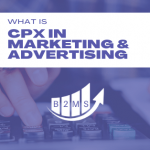Cost-Per-Order CPO Marketing
What is CPO Marketing?
CPO means Cost Per Order and is a marketing metric that is frequently used in online retail and affiliate marketing.
CPS – Cost Per Sale – is also frequently used, which is effectively the same metric.
CPO relates marketing spending to the number of resulting orders but ignores the value of the sales. The metric is used to compare marketing campaigns, channels, or content in terms of their conversion cost.
How to calculate Cost Per Order (CPO)?
The formula for Cost Per Order is very easy to form, but not always easy to determine since the costs cannot be assigned one hundred percent in every case. The total cost is divided by the number of confirmed orders.
CPO = total cost / number of orders

Accordingly, a higher CPO is worse than a lower CPO, because more costs per order are incurred.
CPO Marketing Marketing Use Cases
CPO Marketing is applied when revenue is to be excluded. First, lagging metrics such as cost per order can provide insight into conversion rates. Order volume and optimization can then be looked at another time.
It can also be used to compare campaigns that have very different product prices.
For example, an affiliate marketer may want to test whether different online retailers convert better than others without considering sales. The revenue could be misleading, as different prices and commissions might be paid out. At first glance, you might think that the higher revenue is better, but it could also be that a lower CPO promises more profits in the long run.
Differentiation from other marketing metrics
In online marketing, there are many metrics such as CPC Cost Per Click or CPL Cost Per Lead. In a complete funnel analysis, all CPX metrics should be considered: eCPM, CPC, CPL, CPO, and consequently ROMI.
Return on Marketing Investment (ROMI) is the ultimate metric that calculates the profitability of an entire strategy, as well as individual campaigns.
The abbreviation CPA is sometimes used in the context of CPO. CPA can have many meanings: Cost per Action, Acquisition, or even App Install. The exact term often depends on the platform. But in direct response marketing – when a direct response is expected from a customer, such as a purchase decision – CPA is most often equated with cost per customer acquisition.
However, CPA is mostly used in non-transactional campaigns and B2B marketing, while CPO or CPS are used in affiliate and e-commerce marketing.
For campaigns that target revenue generation, eCPM (effective cost per mille) can also be used as a metric. Similar to ROMI, revenue is taken into account for advertisers. The revenue is compared to the costs per page impression in order to compare formats or marketing channels with each other.
Advantages of CPO marketing
The CPO KPI is based on the successful completion of a transaction – the order. Therefore, this online campaign metric is more reliable for planning than, for example, cost per lead. Cost per order KPI help in scaling for e-commerce marketing as they are not distorted by sales. Orders of different products can therefore be compared more easily.
Additionally, advertisers can use platforms that price on CPO models and therefore only pay for confirmed orders.
Disadvantages of CPO marketing
Looking at CPO in isolation can be misleading, as various factors can influence the number of orders. The conversion optimization of a page, the relevance of an ad to the product, or even the product itself. Therefore, it is advisable to include the CPO metric in the overall evaluation, but not to consider it as the only marketing measure.

Sascha is a Lifecycle Marketing Consultant with over 8 years of digital marketing experiences in Silicon Valley, the UK, and Germany.
After leading the demand generation for a 100+ million company, he decided to venture out on himself. He’s now helping clients to attract and convert more leads and customers.
His main focus are SEO, paid media & marketing automation – all with the focus to tie marketing campaigns to revenue.
Sascha has been featured in industry publications.




